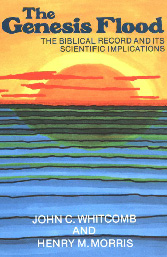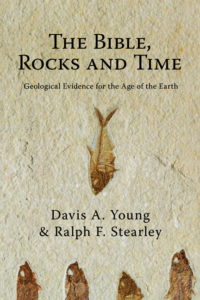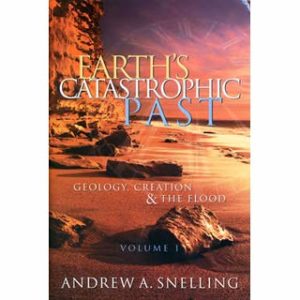In 1961, John Whitcomb and Henry Morris published The Genesis Flood. They intended the work to be a response to Bernard Ramm, who in 1954 had published a work arguing that Noah’s Deluge was a local catastrophe. Borrowing heavily from George McCready Price (1870-1963), a Seventh-Day Adventist author, Whitcomb and Morris contended that the flood of Noah’s day accounts for practically all the geological record. By any standard, the book was a publishing success with over 300,000 copies sold. The Genesis Flood launched the modern young-earth creationism (YEC) movement.
They intended the work to be a response to Bernard Ramm, who in 1954 had published a work arguing that Noah’s Deluge was a local catastrophe. Borrowing heavily from George McCready Price (1870-1963), a Seventh-Day Adventist author, Whitcomb and Morris contended that the flood of Noah’s day accounts for practically all the geological record. By any standard, the book was a publishing success with over 300,000 copies sold. The Genesis Flood launched the modern young-earth creationism (YEC) movement.
In 2008, old-earth geologist Davis Young, along with co-author Ralph Stearley, published The Bible, Rocks and Time. Young and Stearley’s book is a revision of Davis’ earlier Christianity and the Age of the Earth. In 2009, young-earth geologist Andrew Snelling published Earth’s Catastrophic Past, a two volume work intended to update Whitcomb and Morris’ seminal work. 
Reading Andrew Snelling’s Earth’s Catastrophic Past and Davis Young’s The Bible, Rocks and Time side by side is a surreal experience. Both men are professional geologists, and both books exhibit the proficiency and expertise of their respective authors. Snelling’s two volume set argues for young-earth creationism and that Noah’s flood created the preponderance of the geological record. Young and his co-author, Ralph Stearley, present the case for an ancient earth and that Noah’s flood was a local phenomenon. The two works together total over 1500 pages. Reading them together can give a person cognitive whiplash. 
Snelling is thorough in his presentation. He realizes that he is arguing against the consensus view of the geological community and therefore must meticulously make his case. Davis and Stearley give more attention to the historical development of the debate about the age of the earth, but they also give methodical attention to the evidences for their position. Both books attempt to make their respective cases via cumulative arguments—piling up one example after another. Snelling and Young often present the same geological data—the geological column of the Grand Canyon, the mid-Atlantic ridge, coral reefs, etc. But they almost always arrive at diametrically opposite conclusions.
What is going on here? There are at least four possible explanations: (1) The postmodernists and deconstructionists are right–all meaning is subjective and is created by the reader. In this case the text is the geological column and the readers are the geologists. (2) At least one side is engaged in deliberate deceit. (3) Spiritual forces are at work. One side is blinded by the evil one while the other’s mind is divinely illuminated. Or (4) at least one side has an almost pathological inability to see the truth. These blind spots render them unable to see what should be obvious.
None of the four above possibilities are very good. The postmodernist answer (1), is self-referentially contradictory. Deconstructionism may work as a descriptor but fails as a philosophy. As for explanation (2), there is nothing about Snelling or Davis that indicates either would be willing to deceive or be deliberately dishonest. As for (3), Christians have no doubt about spiritual warfare, and that spiritual battles occur in every avenue of human endeavor, and this includes the scientific realm. However, both Davis and Snelling (and the respective Christian communities they represent) affirm the Lordship of Jesus Christ over their vocations as geologists. Both are servants of Christ. The present authors are in no position to make a spiritual determination about either one. Of the four possible explanations, the phenomenon of blind spots (4) is the most likely.
Explanation (4) is also the most optimistic, even if one or both sides seem to be intransigent. Here the community of faith can play a crucial role. If Davis and Snelling, and others who hold to their respective views, will meet, talk, and pray together; if they will allow other godly, concerned, and informed brethren to speak truth into their lives; if they will be humble enough to acknowledge their respective blind spots, then it will be possible for progress to be made and for some type of consensus to be achieved. As it stands now, the dissonance between the two geologists and their respective books is so great that one has to wonder if they are looking at the same planet.
(The above is an excerpt from 40 Questions about Creation and Evolution, coauthored by Mark Rooker and me. Part 2 will survey the flood model proposed by Whitcomb and Morris.) 
This may be construed as a bit of shameless self promotion, but another book deserves to be part of this discussion: “The Grand Canyon, Monument to an Ancient Earth – Can Noah’s Flood Explain the Grand Canyon?” In chapter 3 of this book, we present the young earth/flood geology view of the Grand Canyon, then in chapter 4 we present the old earth/conventional geology view. In the remainder of the book, we present evidence under several geologic subject areas (e.g., geomorphology, paleontology, structural geology) which argues against the young earth/flood geology view. Much of that evidence is in the form of photographs, to help the reader realize that interpretation isn’t just dependent on world view. The book can be purchased at Grand Canyon National Park bookstores and the usual online outlets.
Hi Tim, indeed! Your book is excellent and I hope it gets into the hands of Christians everywhere.
[…] Keathley is at it again. His latest blog post, “The Extent of Noah’s Flood: the Geological Evidence (Part 1)”, is an excerpt from the book he coauthored with Mark Rooker, 40 Questions about Creation and […]
You know, just reading those 4 options it occurred to me that they very well fit the abortion debate too.
Hadn’t thought about it, but I see your point.
I appreciate the integrity in this post.
I strongly suspect there is a pretty good explanation – one of the parties has a VERY strong pre-suppositional approach that requires a particular conclusion….
Hmmmm…. I wonder which one it is…;-)